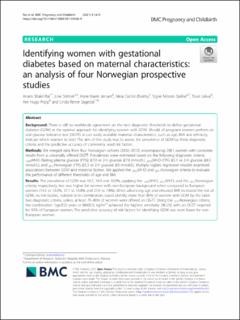| dc.description.abstract | Background: There is still no worldwide agreement on the best diagnostic thresholds to define gestational diabetes (GDM) or the optimal approach for identifying women with GDM. Should all pregnant women perform an oral glucose tolerance test (OGTT) or can easily available maternal characteristics, such as age, BMI and ethnicity, indicate which women to test? The aim of this study was to assess the prevalence of GDM by three diagnostic criteria and the predictive accuracy of commonly used risk factors. Methods: We merged data from four Norwegian cohorts (2002–2013), encompassing 2981 women with complete results from a universally offered OGTT. Prevalences were estimated based on the following diagnostic criteria: 1999WHO (fasting plasma glucose (FPG) ≥7.0 or 2-h glucose ≥7.8 mmol/L), 2013WHO (FPG ≥5.1 or 2-h glucose ≥8.5 mmol/L), and 2017Norwegian (FPG ≥5.3 or 2-h glucose ≥9 mmol/L). Multiple logistic regression models examined associations between GDM and maternal factors. We applied the 2013WHO and 2017Norwegian criteria to evaluate the performance of different thresholds of age and BMI. Results: The prevalence of GDM was 10.7, 16.9 and 10.3%, applying the 1999WHO, 2013WHO, and the 2017Norwegian criteria, respectively, but was higher for women with non-European background when compared to European women (14.5 vs 10.2%, 37.7 vs 13.8% and 27.0 vs 7.8%). While advancing age and elevated BMI increased the risk of GDM, no risk factors, isolated or in combination, could identify more than 80% of women with GDM by the latter two diagnostic criteria, unless at least 70–80% of women were offered an OGTT. Using the 2017Norwegian criteria, the combination “age≥25 years or BMI≥25 kg/m2 ” achieved the highest sensitivity (96.5%) with an OGTT required for 93% of European women. The predictive accuracy of risk factors for identifying GDM was even lower for nonEuropean women.
Conclusions: The prevalence of GDM was similar using the 1999WHO and 2017Norwegian criteria, but substantially higher with the 2013WHO criteria, in particular for ethnic non-European women. Using clinical risk factors such as age and BMI is a poor pre-diagnostic screening method, as this approach failed to identify a substantial proportion of women with GDM unless at least 70–80% were tested. | en_US |

